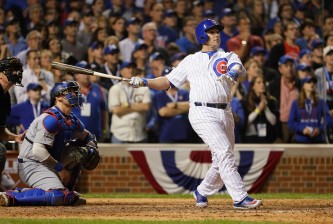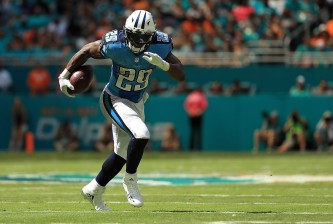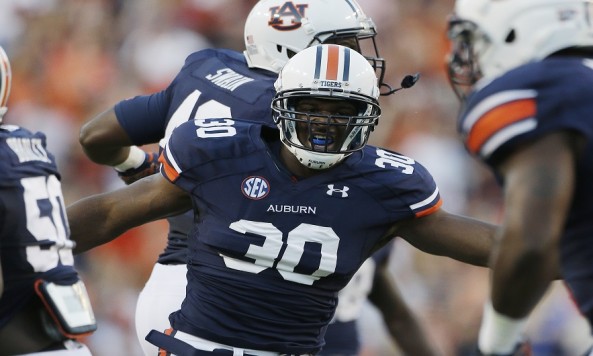Projecting an NFL draft prospect’s ceiling is primarily based on film study and physical attributes, but it’s always fun to compare draft hopefuls to current NFL players. The 2014 NFL draft class has no shortage of players that resemble present-day NFLers, which makes it easy to find similarities between the stars of today and the premier players of tomorrow.
QB Blake Bortles, Central Florida
NFL comparison: QB Ben Roethlisberger, Pittsburgh Steelers
Bortles and Roethlisberger are similar in many ways. Both were late-bloomers athletically, each one having had to wait until they were in college to truly find success under center. Each has the lower body strength to bounce off of pass rushers and also drive the ball down the field. Bortles is the type of quarterback that can make his teammates better, which is exactly what Roethlisberger has done for the better part of the last ten years. The former Knight is well on his way to stardom.
QB Johnny Manziel, Texas A&M
NFL comparison: QB Russell Wilson, Seattle Seahawks
The most exciting player in this year’s class, Manziel turns broken plays into touchdowns on a regular basis. Like Wilson, the former Aggie may be shorter than the average signal caller, but he compensates by finding throwing lanes and lighting up defenses. Both quarterbacks have incurred criticism for a perceived lack of arm strength, but the concerns, in both cases, are unwarranted.
QB Teddy Bridgewater, Louisville
NFL comparison: QB Aaron Rodgers, Green Bay Packers
Bridgewater is the best quarterback I’ve graded since Andrew Luck. While he’s athletic enough to keep plays alive in the pocket, Bridgewater’s best attribute is his touch on throws. He and Rodgers are similar in that neither one has a truly noticeable flaw. Both quarterbacks can make every NFL throw required of them without issue.
WR Mike Evans, Texas A&M
NFL comparison: WR Vincent Jackson, Tampa Bay Buccaneers
Analysts tend to forget that along with his big frame and prodigious catch radius, Mike Evans can run. He shredded Cover-2 defenses in college because of his awareness as a route runner, which will help him acclimate to the NFL rather quickly. Like Jackson, Evans is a big-bodied, vertical threat who will legitimize any team’s downfield passing game. Look for this receiver to hear his name called early on draft day.
WR Sammy Watkins, Clemson
NFL comparison: WR Reggie Wayne, Indianapolis Colts
I struggled with this comparison, because as much as I wanted to compare Watkins to Andre Johnson, the Clemson standout just isn’t as strong as the Texans WR. Instead, think of Watkins as a Reggie Wayne clone. The two are similar in frame, straight-line speed and both are fantastic route runners. While Wayne isn’t as much of a big play threat as some may project Watkins to be, it’s doubtful that the former Tiger will continue to be as lethal as he was in college, taking the top off opposing defenses.
RB Ka’Deem Carey, Arizona
NFL comparison: RB LeSean McCoy, Philadelphia Eagles
While some might opine that a McCoy comparison is high praise for the former Wildcat, Carey makes a strong case for consideration as the best rusher in the class. With the ability to cut on a dime, Carey emulates McCoy in the open field. The two are similar physically as well, with almost an identical frame and comparable straight-line speed. In terms of lateral quickness, the two are off the charts.
RB Tre Mason, Auburn
NFL comparison: RB Marshawn Lynch, Seattle Seahawks
Always finding a way to fall forward at the end of runs, Mason is the type of running back whose per-carry averages will be slightly better than they should be. Like Lynch, Mason runs downhill with a tremendous amount of momentum. Though neither of the two rushers have breakaway speed, each one has a dizzying array of moves in the open field to evade would-be tacklers. Mason will do best in a scheme that utilizes his between-the-tackles prowess.
Auburn RB Tre Mason mentions Marshawn Lynch as a player he wants to run like.
— Bob Condotta (@bcondotta) February 22, 2014
TE Eric Ebron, North Carolina
NFL comparison: TE Vernon Davis, San Francisco 49ers
Ebron roasts man coverage and is no match for opposing defensive backs/linebackers. Davis has been doing this for years. Both are representative of a new era in football in which the tight end is an in-line receiver. Davis is one of the most athletic tight ends in the history of football and Ebron could follow suit. The former North Carolina star has legitimate speed and, though his route running stands to improve, he’ll beat linebackers and DBs at the next level by virtue of his quickness.
OT Greg Robinson, Auburn
NFL comparison: OT Trent Williams, Washington Redskins
Coming out of college, Williams wasn’t as pro-ready as some of his counterparts, but he ended up as a high draft pick because of his immense potential. Robinson is the same way. He’s not a finished product, but his impressive athleticism and natural footwork has talent evaluators excited. Robinson could end up being a premier tackle, like Williams, but needs to become a more consistent pass blocker.
OG David Yankey, Stanford
NFL comparison: OG Andy Levitre, Tennessee Titans
Levitre is one of the NFL’s best blockers in space, pulling efficiently and getting to the second level well. Yankey is very similar in that he keeps his feet under him in the open field and is capable of stonewalling linebackers in pursuit. At Stanford, Yankey was tasked with pulling on a good number of sweeps and outside runs. He executed his blocks to perfection in college and figures to do much of the same in the NFL.
DE Jadeveon Clowney, South Carolina
NFL comparison: DE Jason Pierre-Paul, New York Giants
Analysts will compare Clowney to Julius Peppers or Jevon Kearse, but I don’t love the former Gamecock as much as others do. To me, Clowney is a very athletic pass rusher who will see measured success at the next level, but I don’t know if he’s a cornerstone, every-down player. Pierre-Paul is a very good player thanks to his physical gifts, but he isn’t consistently elite, especially against the run. Such is a reasonable outcome for Clowney.
But it’s hard to ignore how athletic he is:
At 264 pounds, Jadeveon Clowney scored a 71 on his speed of movement test on the force plate today. Similar score to Devin Hester. …
— Albert Breer (@AlbertBreer) April 25, 2014
LB Dee Ford, Auburn
NFL comparison: LB Cameron Wake, Miami Dolphins
Wake is an explosive pass rusher whose first step is deadly. Ford has the same first step and the former Tiger wreaks havoc on the edge. The two defenders are almost identical in terms of frame and both make plays in the backfield with relative frequency. Personally, I grade out Ford a lot higher than most other analysts. He’s a fierce sack artist whose arsenal of pass rushing moves is tremendous.
LB Anthony Barr, UCLA|
NFL comparison: LB Aaron Maybin, CFL
Though the general consensus is that Maybin was a ‘bust’, he was simply an efficient pass rusher that got overdrafted. What that means is that Maybin couldn’t meet (unrealistic) expectations as a first round pick, but he ended up being a solid player for a number of years. Barr has almost no experience on defense and he lacks the instincts to be a top-level linebacker. That said, he can end up as a solid, if underwhelming, edge rusher in due time, with the proper coaching.
LB C.J. Mosley, Alabama
NFL comparison: LB David Harris, New York Jets
Harris is a very good linebacker. He has otherworldly instincts, is a hard hitter and barks out defensive audibles as well as few other middle linebackers. That said, Harris, like Mosley, is a liability in coverage and struggles to get into his pass drops. Mosley will struggle to make much of an impact in zone coverage and could end up coming off of the field on third down, but he’s a special talent nonetheless.
LB Andrew Jackson, Western Kentucky
NFL comparison: LB Erin Henderson, Minnesota Vikings
Another thumper who can’t cover receivers, Jackson has seen his draft stock plummet over the course of what was a poor final season. He’s not nearly as good as Mosley, but the former mid-major star will be an impactful linebacker on first and second downs wherever he ends up. Like Henderson, Jackson punishes ballcarriers and tackles well. He’s more talented than evaluators give him credit for and could end up sneaking into the middle rounds.
LB Khalil Mack, Buffalo
NFL comparison: LB Brian Orakpo, Washington Redskins
One of the best athletes in the NFL, Orakpo is a true swiss army knife for the Redskins. He can rush the passer, punish a ballcarrier and cover zone. Such is exactly what Mack brings to the table. The small-school star does everything well and has a foundation of raw, impressive athleticism to boot. He’s the type of defender that can turn a game around single-handedly, which will allow him to be an instant impact player.
CB Darqueze Dennard, Michigan State
NFL comparison: CB Dee Milliner, New York Jets
It’s probably too early to be using Dee Milliner’s in these articles, but Dennard and the Jets CB are too similar not to compare. Both corners are physical, grabby defenders that bully receivers at the line of scrimmage. Milliner’s fluid hips are similar to those of Dennard. Both are well-versed in man coverage and shadow receivers as well as any other cornerback in their respective draft classes.
CB Jason Verrett, Texas Christian
NFL comparison: CB Prince Amukamara, New York Giants
The truth is that Verrett is probably a bit faster than Amukamara, but the two are actually very alike in terms of playing style. Both are extremely technically sound defensive backs that rely on nearly flawless technique to lock down opposing receivers in man coverage. Amukamara is an inch or two taller (and a few pounds heavier, too), so the comparison isn’t perfect, but Verrett grades out very similar to the Giants CB.
S HaHa Clinton-Dix, Alabama
NFL comparison: S Bernard Pollard, Tennessee Titans
Clinton-Dix isn’t a first round talent. He’s not as ‘rangy’ as some analysts will have you believe and his skills in zone coverage leave a lot to be desired. That said, like Pollard, Clinton-Dix makes up for a perceived lack of range by laying the wood in the run game and punishing receivers that go deep over the middle of the field. Clinton-Dix is an athletic, hard-hitting defensive back who will have a solid career.
S Calvin Pryor, Louisville
NFL comparison: S T.J. Ward, Denver Broncos
Ward isn’t a flawless safety, but he remains one of the league’s best because of his all-around skill set. If you get a chance, watch Blake Bortles’ famous final drive against Louisville, in which he marches his UCF Knights down the field and scores the game-winning touchdown. He doesn’t throw to Pryor’s side once. The defensive back commands respect with his ability to cover zone well and take down opposing running backs.























